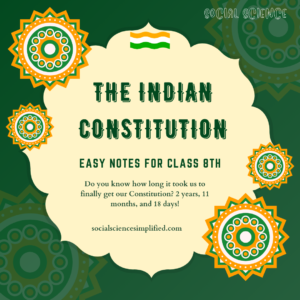Introduction:
This chapter deals with basic knowledge of the constitution. Basically, it would make you understand the need of a constitution and how the Indian constitution came into effect. Lastly, you would read about the key features in the Indian Constitution.
Why does a country need a Constitution?
Before we discuss the need, let’s understand the purpose. These are:-
- It lays out certain ideals that form the basis of the kind of country that we as citizens aspire to live in.
- The second purpose of a Constitution is to define the nature of a country’s political system.
- Third, the Constitution helps to save us from ourselves. It means the constitution guards us against the decision that might affect our larger interests.
You know, these three purposes itself tell the need of a constitution.
- The Constitution usually contains rules that ensure that all the rules are equally available to both minority and majority.
- It also prevent domination of one community over other.
- It has provisions for the protection of fundamental rights (Article 14 to 32) of the citizens also.
- Moreover, a constitution limit the power of government in order to reduce the chance of arbitrary rule.
- The constitution plays a crucial role in laying out certain important guidelines that govern decision-making.
The Indian Constitution: Key Features
- In 1946, the Indian leaders formed the constitutional Assembly.
- The objective was to give their abstract ideas a concrete form. Initially, The assembly had 300 members.
- It was not an easy task to integrate people from different communities, backgrounds and religions.
- However, approximately in three years’ journey they (members of constituent assembly) successfully accomplished the goal.
- Finally, The Indian constitution came into force on 26th January 1950.
Key Features:
- Federalism: It means the existence of more than one level of government in country.
- For example: India has a three tier system in which there is government at the national, state and local level. Each level has its own lists except the local level.
- Parliamentary Form of Government: The Constitution of India guarantees universal adult suffrage for all citizens. This right to vote gives the people a chance to have a direct role. Since people elect the leaders, these representatives are accountable to them (people).
- Separation of Powers: There are three organs of the government in the country. Each one has same level but different functions. Also, each organ acts as a check on the other organs of the state and this ensures the balance of power between all three.
- For example: The legislature is a law making body consist of elected representatives.
- The executive implements the laws and run the government.
- Lastly, the judiciary refers to the system of courts. It prevent the misuse of power by any one branch of the State.
- Fundamental Rights: The Indian constitution contains six fundamental rights. These rights are inviolable.
- Right to Equality ( Article 14 to 18)
- Right to Freedom (Article 19 to 22)
- Right against Exploitation. (Article 23 & 24)
- Right to Freedom of Religion. (Article 25 to 28)
- Cultural and Educational rights. (Article 29 &30)
- Right to Constitutional Remedies. (Article 32)
- Secularism: A secular state is one in which the state does not officially promote any one religion as the state religion.



Very nice notes
Thankyou, Praneeta.
Very nice and very very beautiful notes
Thankyou so much for your lovely comment.
please add the fundimental rights in the notes?
Fundamental rights are already there, Mhairi bose.
Thank you so much